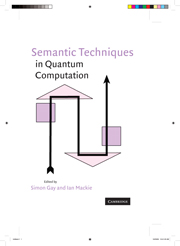Book contents
- Frontmatter
- Contents
- Contributors
- Preface
- 1 No-Cloning in Categorical Quantum Mechanics
- 2 Classical and Quantum Structuralism
- 3 Generalized Proof-Nets for Compact Categories with Biproducts
- 4 Quantum Lambda Calculus
- 5 The Quantum IO Monad
- 6 Abstract Interpretation Techniques for Quantum Computation
- 7 Extended Measurement Calculus
- 8 Predicate Transformer Semantics of Quantum Programs
- 9 The Structure of Partial Isometries
- 10 Temporal Logics for Reasoning about Quantum Systems
- 11 Specification and Verification of Quantum Protocols
- Index
- References
6 - Abstract Interpretation Techniques for Quantum Computation
Published online by Cambridge University Press: 05 July 2014
- Frontmatter
- Contents
- Contributors
- Preface
- 1 No-Cloning in Categorical Quantum Mechanics
- 2 Classical and Quantum Structuralism
- 3 Generalized Proof-Nets for Compact Categories with Biproducts
- 4 Quantum Lambda Calculus
- 5 The Quantum IO Monad
- 6 Abstract Interpretation Techniques for Quantum Computation
- 7 Extended Measurement Calculus
- 8 Predicate Transformer Semantics of Quantum Programs
- 9 The Structure of Partial Isometries
- 10 Temporal Logics for Reasoning about Quantum Systems
- 11 Specification and Verification of Quantum Protocols
- Index
- References
Summary
Abstract
In this chapter, we present applications of abstract interpretation techniques in quantum computing. Quantum computing is a now well-established domain of computer science, and the recent developments of semantic techniques show the vitality of this rapidly growing area. On the other hand, the proof has been made that abstract interpretation is a powerful theory (of “classical” computer science) for comparing more or less precise semantics of the same programming language. In a more general picture, abstract interpretation can be seen as a framework for comparing the precision of several representations of the same dynamic system evolution. In this paper, we point out that abstract interpretation can be fruitfully used in quantum computing: (i) for establishing a hierarchy of quantum semantics and (ii) for analyzing entanglement evolution.
6.1 Introduction
The field of quantum information processing is growing rapidly. This development is based on the exploitation of nonclassical phenomena such as superposition and entanglement, which gave rise to new protocols (cryptographic protocols with unconditional security, Bennett 1992; Bennett and Brassard 1984; teleportation Bennett et al. 1993), and new algorithms (polynomial time factorization, Shor 1994 and search algorithms (Grover 1996)).
Some recent developments in quantum information processing are based on the use of high-level methods, adapting and extending the methods successfully used in classical computation (Abramsky and Coecke 2004; Gay and Nagarajan 2005, 2006; Gay et al. 2008; Kashefi 2003; Lalire and Jorrand 2004; Selinger 2004c, d).
- Type
- Chapter
- Information
- Semantic Techniques in Quantum Computation , pp. 206 - 234Publisher: Cambridge University PressPrint publication year: 2009
References
- 2
- Cited by

